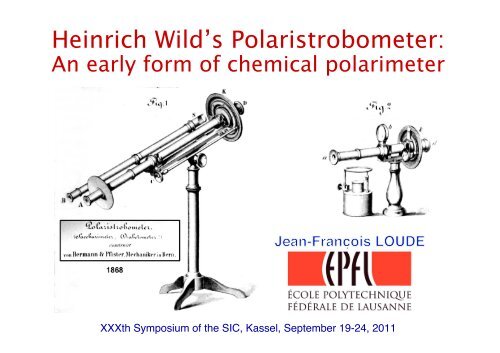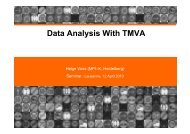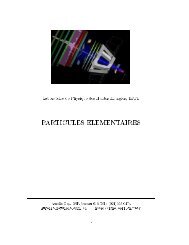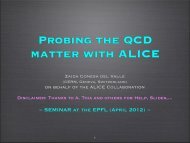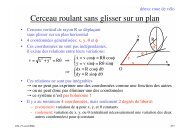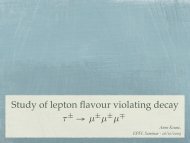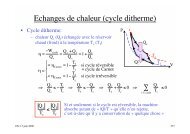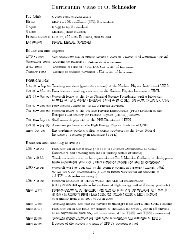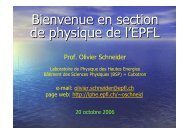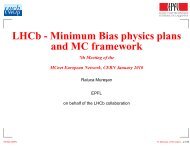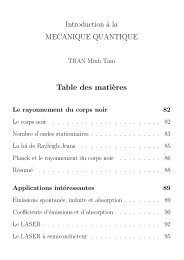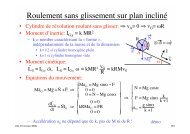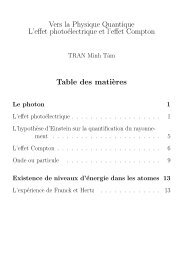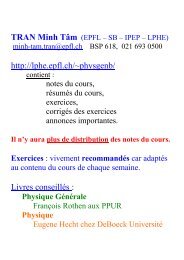Polaristrobometers - EPFL
Polaristrobometers - EPFL
Polaristrobometers - EPFL
You also want an ePaper? Increase the reach of your titles
YUMPU automatically turns print PDFs into web optimized ePapers that Google loves.
Heinrich Wild’s Polaristrobometer:<br />
An early form of chemical polarimeter<br />
XXXth Symposium of the SIC, Kassel, September 19-24, 2011!
Abstract<br />
Heinrich Wild’s Polaristrobometer: An early form of chemical polarimeter<br />
The year 2011 having been proclaimed by UNESCO and IUPAP “International Year of<br />
Chemistry”, it seems fitting to have a close look at a physical chemistry instrument, the<br />
Polaristrobometer, an early form of polarimeter/saccharimeter, at its inventor, the Swiss<br />
physicist Heinrich Wild, at its enthusiastic reception by chemists, and at its principal<br />
manufacturer, Hermann & Pfister at Bern.<br />
Heinrich Wild (1833-1902) was appointed professor of physics at the University of Bern<br />
and director of the (mainly meteorological) Observatory in 1858. Called in 1868 to the<br />
direction of the Central Physical (Meteorological) Observatory in Saint Petersburg, he spent<br />
the next 27 years in Russia, extending enormously the network of observing stations and<br />
working on the improvement and standardisation of meteorological instruments. He retired to<br />
Zurich in 1895.<br />
His Polaristrobometer, first described in 1865, is built around the very sensitive<br />
polariscope invented by Savart a quarter of a century earlier. To achieve the measurement of<br />
the angle of rotation of the plane of polarisation of monochromatic light by optically active<br />
substances, the polariser is rotated until a network of parallel interference fringes disappears,<br />
as opposed to the more modern types of polarimeters where one looks for an equality of tint<br />
or of luminosity of two or more adjacent fields. This truly original, precise and practical<br />
polarimeter remained the best one available until the end of the 19 th century, when it was<br />
superseded by instruments less prone to systematic errors and more convenient to use.<br />
That the Polaristrobometer was much in demand by chemists and commercially successful<br />
is shown by the many citations and images in physics textbooks and, above all, by the long<br />
descriptions and detailed instructions appearing in books and articles written by chemists<br />
from 1875 onwards, notably by the pioneer of polarimetry H. Landolt. Today, many<br />
<strong>Polaristrobometers</strong> can be found, often unidentified, in remote corners of science museums.<br />
Hermann & Pfister (later Pfister & Streit) at Bern became the main, but not exclusive<br />
manufacturer of this instrument. A model of reduced size (tubes of 50 mm instead of 220<br />
mm) was first made by J. G. Hofmann at Paris and by Dr. Meyerstein at Göttingen. Both<br />
models are still mentioned in the 1896 catalog of Schmidt & Haensch at Berlin.<br />
— 2 —!<br />
JFL / SIC / Kassel / 19-24.09.2011
Preliminary RemarkS<br />
1) No known relationship between!<br />
Heinrich WILD (1877-1951), the famous builder of surveying instruments and<br />
founder of “Wild Heerbrugg”, and the (almost) forgotten Heinrich (von) WILD<br />
(1833-1902), meteorologist and inventor of the Polaristrobometer. !<br />
2) Chemical Polarimeter:!<br />
Measures the rotation of the plane of polarisation of light, generally monochromatic<br />
(sodium yellow light, λ = 589 nm), by chemically “active” substances, mainly liquids<br />
or solutions.!<br />
3) Saccharimeter:!<br />
Polarimeter specially designed to measure the sugar content of solutions, for<br />
technical use in the sugar industry (cane, beet) or for medical / pharmaceutical use<br />
(analysis of urine for diabetes diagnostic). !<br />
It normally works with a white light source and is provided with a scale giving directly<br />
the sugar content.!<br />
Wild promoted his Polaristrobometer as a Saccharimeter/Diabetometer, altough it is<br />
fundamentally a general purpose polarimeter. Those made by Hermannn & Pfister<br />
have 2 scales: one giving the angle, the other the sugar content.!<br />
— 3 —!<br />
JFL / SIC / Kassel / 19-24.09.2011
Polarisation : A short Chronology<br />
• 1808 !Malus: linear polarisation of light!<br />
• 1811 !Arago: quartz (⊥) rotates the plane<br />
!polarisation of light!<br />
• 1815 !Biot: rotation by turpentine, sugars<br />
!(also Seebeck), etc.!!<br />
• >1815 !Biot: laws of polarimetry!<br />
• 1822 !Fresnel: linear polarisation = !<br />
2 x contrary-rotating circular pol.!<br />
• 1848 !Pasteur: mirror-image molecules<br />
!(salts of tartaric acid)!<br />
• 1879 !Landolt: Das optische Drehungs-!<br />
! !vermögen organischer Substanzen!<br />
— 4 —!<br />
• 1828 !Nicol: “nicol” (calcite polariser)!<br />
• 1844 !Mitscherlich: improved Biot<br />
!polarimeter (using nicols)!<br />
• 1845 !Robiquet-Soleil: “tint of passage”<br />
!polarimeter (bi-quartz ⊥)!<br />
• 1868 !Wild: improved Polaristrobometer!<br />
• 1870 !Duboscq (Jellet-Cornu) half-shade<br />
!polarimeter!<br />
• 1874 !Laurent: half-shade polarimeter!<br />
• 1881 !Glan-Thomson polariser!<br />
• 1885 !Lippich: half-shade polarimeter!<br />
JFL / SIC / Kassel / 19-24.09.2011
Eyepiece<br />
Analyser<br />
(rotating)<br />
Chemical Polarimeter<br />
Sample tube (typ. 5 cm – 20 cm)<br />
— 5 —!<br />
Polariser<br />
H. H. Landolt: Drehungsvermögen …!<br />
(1879) S. 91, Fig. 20!<br />
¿ How to increase the sensitivity ?!<br />
Lamp<br />
Device X:<br />
—————— Mitscherlich (any wavelength λ)<br />
Bi-quartz (⊥) Soleil-Robiquet “sensitive tint” (white light)<br />
Savart plate Wild Polaristrobometer (fringes, best with D-line)<br />
Split nicol Jellet-Cornu-Duboscq “half-shade” (fixed angle, D-line)<br />
Quartz ( // ) Laurent “half-shade” (variable angle, D-line)<br />
Small nicol Lippich “half-shade” (variable angle, any λ)<br />
JFL / SIC / Kassel / 19-24.09.2011
H. WILD’s Life & Work : An Overwiew<br />
• 1833 Birth near Zurich<br />
• 1833–1858 Physics studies<br />
• 1858–1868 Professor at Bern<br />
• 1868–1895 Called to Saint Petersburg (Russia), as Director of<br />
the Central Physical (meteorological) Observatory<br />
• 1895 His Excellency Heinrich von Wild, “Wirklicher<br />
Staatsrat”, member of the Imperial Academy of<br />
Sciences, retires after 27 years of intense activity<br />
• 1902 Death at Zurich<br />
Mainly active in:<br />
— Meteorology & earth magnetism<br />
— Scientific instruments<br />
— Metrology<br />
More about H. Wild in:<br />
http://lphe.epfl.ch/publications/2011/JFL_SPS_2011_2.pdf<br />
— 6 —!<br />
JFL / SIC / Kassel / 19-24.09.2011
The Polaristrobometer (1864, improved1869)<br />
From 1850, polarimetry becomes an important field of<br />
chemical research.<br />
Improved saccharimeters are needed by the sugar industry.<br />
Polarimeters available in the mid-1860s (Mitscherlich) do not<br />
allow a precise enough determination of the angle of rotation<br />
with a liquid sample of reasonable length (about 20 cm)<br />
using monochromatic light.<br />
— 7 —!<br />
Light transmission shows<br />
two broad minima.<br />
Determination of extrema<br />
of response problematic !<br />
Something better is needed!<br />
JFL / SIC / Kassel / 19-24.09.2011
The Polaristrobometer, invented in 1864 while Wild was professor<br />
at Bern, answers the needs of the chemists.<br />
Original: shows interference fringes instead of changes of tints<br />
or luminosity in one or more adjacent fields.<br />
The pattern of fringes disappears at 4 sharply defined,<br />
(almost exactly) equidistant, (easily missed!) angular positions.<br />
— 8 —!<br />
JFL / SIC / Kassel / 19-24.09.2011
Optical system of the small Polaristrobometer (50 mm tubes)<br />
Rotating polariser!<br />
(Nicol prism)!<br />
Liquid!<br />
sample!<br />
Dr. H. Wild: Ueber ein neues Polaristrobometer (Bern, 1865)!<br />
SAVART POLARISCOPE!<br />
Savart plate!<br />
(2 quartz crystals)!<br />
Müller-Pouillets: Physik Bd. II !<br />
(10. Auf., 1909) S. 1011, Fig. 857!<br />
— 9 —!<br />
Analyser!<br />
(Nicol)!<br />
Remark: thick quartz plates later replaced by much thinner (2–3 mm) calcite plates!<br />
The polarizer is<br />
rotated (slowly!)<br />
until the fringes<br />
disappear!<br />
4 fringeless<br />
angular<br />
positions!<br />
JFL / SIC / Kassel / 19-24.09.2011
The improved Polaristrobometer of 1869 (tube length up to 220 mm):<br />
• Polarimeter/saccharimeter with rotating polarizer<br />
• Telescopic readout of angular position<br />
• To be preferably used with monochromatic light (for instance Na lamp)<br />
• Luminous: light transmission is high<br />
H. Wild: Über die neueste Gestalt meines <strong>Polaristrobometers</strong> (Saccharimeter, Diabetometer)!<br />
Bull. Acad. impériale des Sciences de Saint-Pétersbourg Vol. 14 (1870) 149-163 +1 Taf.!<br />
— 10 —!<br />
JFL / SIC / Kassel / 19-24.09.2011
Reception by scientists<br />
• H. G. van de Sande Bakhuyzen (1872):<br />
Zur Theorie des <strong>Polaristrobometers</strong> und des drehenden Nicols<br />
Mathematical analysis of the systematic errors due to inaccuracies<br />
in the construction of the Polaristrobometer, which can be<br />
completely eliminated by measuring in the 4 quadrants and taking<br />
the mean value of the readouts.<br />
• H. BUIGNET (1877):<br />
Manipulations de physique<br />
« L’appareil de M. Wild ne donne pas des résultats très sensibles,<br />
et la persistance des impressions sur la rétine rend les<br />
observations très difficiles. L’œil se fatigue en regardant ces stries<br />
et continue à les voir, lors même qu’elles ont disparu ».<br />
• B. Tollens (1877 and 1878):<br />
Ueber die specifische Drehung des Rohrzuchers<br />
Measurements exclusively made with the large Polaristrobometer<br />
made by Hermann & Pfister, “improved” by increasing the angle<br />
between the Savart plate and the the nicol analyser.<br />
Claims to get ± 3’ (0.05°) readout error (2 quadrants only).<br />
— 11 —!<br />
JFL / SIC / Kassel / 19-24.09.2011
• H. H. LANDOLT (1879), still known for the Landolt-Börnstein Tables:<br />
Das optische Drehungsvermögen organischer Substanzen<br />
Gives a detailed description, describes how best to use it.<br />
Mentions the modifications (improvements ?) made by Tollens.<br />
Compares the results of measurements made with other available<br />
polariscopes: Laurent’s, Mitscherlich’s and Wild’s polarimeters are<br />
in agreement, within 0.1° or less.<br />
— 12 —!<br />
Setup with Na-lamp,<br />
for precision, temperature-<br />
controlled measurements<br />
JFL / SIC / Kassel / 19-24.09.2011
• Dr. C. Gänge (1880):<br />
Die Polarisation des Lichtes im Dienste des Chemikers<br />
« Trotz des höheren Anschaffungspreise, … . ist daher der<br />
Polaristrobometer von Wild unter allen Umständen den anderen<br />
Instrumenten vorzuziehen ».<br />
• Etc., etc.<br />
Until 1914, the Polaristrobometer is mentioned in every book about<br />
chemical polarimetry, as an useful (at least) instrument, and described<br />
in every treatise of physics. But:<br />
• Franz Schmidt & Haensch (1896): Katalog der optischen Instrumente<br />
« Die Wild’schen Apparate sind trotz ihrer Empfindlichkeit für längeres<br />
Arbeiten nicht geeignet, da das Auge sehr angestrengt wird ».<br />
Lippich “half-shade” polarimeter, using Glan-Thompson<br />
polarisers, had been invented (1885).<br />
Wild’s Polaristrobometer was becoming obsolescent.<br />
— 13 —!<br />
JFL / SIC / Kassel / 19-24.09.2011
1865 – 1890:<br />
The Polaristrobometer was a commercial success,<br />
sold in “large” numbers.<br />
Manufacturers:<br />
• Hermann & Pfister (later Pfister & Streit) at Bern<br />
• Franz Schmidt & Haensch (Berlin)<br />
• H. G. Hofmann (Paris) and Meyerstein (Göttingen).<br />
Price: Hermann & Pfister: small instrument Mk 185; large<br />
instrument Mk 385 (including sample tubes, Na-lamp,<br />
transportation box).<br />
“Best” polarimeter from 1870 up to the invention<br />
of the Laurent (1874) and of the Lippich(1885)<br />
“half-shade” polarimeters.!<br />
— 14 —!<br />
JFL / SIC / Kassel / 19-24.09.2011
“Half-shade” Polarimeters:<br />
Jellet-Cornu-Duboscq, Laurent, Lippich, …<br />
Comparison of the luminosities of 2 (or 3) adjacent fields:<br />
The human eye (and later photocells) are<br />
excellent comparators of luminosity => much<br />
increased sensitivity, but low light transmission.<br />
— 15 —!<br />
JFL / SIC / Kassel / 19-24.09.2011
1868–1895: Wild at St-Petersburg<br />
27 years of prodigious activity !<br />
Active in meteorology, terrestrial magnetism<br />
(Pavlovsk Observatory 1878), metrology, polar<br />
research. !<br />
Participates in or chairs international conferences.!<br />
With his wife Rosa, doesnʼt neglects social life!!<br />
But no time left for polarimetry.!<br />
«The nearest approach<br />
to perfection yet<br />
attained is the Russian<br />
Observatory at<br />
Pavlovsk near St.<br />
Petersburg…»<br />
C. C. Marsh: Magnetic<br />
Observatories of Europe<br />
(1889)!<br />
1895 In ill health, Wild retires and returns to Zurich.!<br />
— 16 —!<br />
JFL / SIC / Kassel / 19-24.09.2011
Back to the Polaristrobometer (1898)<br />
H. Wild: Verbesserung des <strong>Polaristrobometers</strong> !<br />
Vierteljahrsschrift der Naturforschenden Gesellschaft in Zürich,!<br />
43. Jahrgang, 1898, S. 37-80 + 1Taf.!<br />
— 17 —!<br />
• Wild recognises that his<br />
Polaristrobometer has been<br />
replaced by better<br />
instruments. He has a new,<br />
improved one built by Pfister &<br />
Streit at Bern:<br />
• Convertible to half-shade<br />
(“Halbschatten”) polarimeter<br />
• Several other improvements<br />
such as a rotating analyser,<br />
and Glan-Thompson polarisers<br />
• Wild claims his new<br />
Polaristrobometer to be twice<br />
as sensitive in fringe-mode<br />
than in half-shade mode<br />
• Not a commercial success<br />
JFL / SIC / Kassel / 19-24.09.2011
Acknowledgements<br />
Without Dr. R. Saba, who gave me a<br />
Polaristrobometer he had salvaged many years<br />
ago, I would never have been incited to study the<br />
life of Heinrich Wild and explore the mysteries (for<br />
a physicist) of chemical polarimetry.<br />
I am very grateful to the <strong>EPFL</strong>, through my<br />
laboratory, the LPHE, for its continued support.<br />
— 19 —!<br />
JFL / SIC / Kassel / 19-24.09.2011
Selected bibliography (in chronological order)<br />
1) Life of H. Wild<br />
— Dr. J. MAURER : Prof. Dr. Heinr. von Wild 1833–1902; Nekrolog in<br />
Verhandlungen der Schweizerischen Naturforschenden Gesellschaft, Vol. 85 (1902) 84-89<br />
— Ferdinand RUDIO und Carl SCHRÖTER : Heinrich Wild (1833–1902); Nekrolog in<br />
Vierteljahrsschrift der Naturforschenden Gesellschaft in Zürich, 47. Jahrgang (1902)<br />
443-451<br />
[partial reproductions of the obituary written by MAURER, of another one by RYKATSCHEW<br />
published in NZZ Nr. 354 (1902), followed by the article written by Karl SPITTELER “Die<br />
Freitag-Abende im Petersburger Observatorium. Zum Andenken an Staatsrat von Wild”,<br />
published in NZZ Nr. 250 (1902) Morgenblatt S.1.]<br />
— Rosa v. WILD: Erinnerungen (gewidmet dem Andenken meines Gatten Heinrich v. Wild […]<br />
iv, 193 S.; Ill; 8° (1913)<br />
— J. C. POGGENDORFF : Biographisch-Literarisches Handwörterbuch zur Geschichte der<br />
exacten Wissenschaften … Bd. II S. 1325, Bd. III. S. 1444-5 und Bd. IV S. 1636-8<br />
[with an almost complete list of his more than 100 scientific publications]<br />
— Charles Coulston GILLISPIE, ed.: Dictionary of Scientific Biography, Vol. 13 & 14 pp. 356-7<br />
(New York: Scribner 1970-1990)<br />
— 20 —!<br />
JFL / SIC / Kassel / 19-24.09.2011
2) Scientific work<br />
• H. Wild: Ueber ein neues Saccharimeter; Annalen der Physik (1864) 626-630<br />
• H. Wild: Ueber ein neues Polaristrobometer (Saccharimeter, Diabetometer) und eine neue<br />
Bestimmung der Drehungsconstante des Zuckers<br />
(Bern: Haller‘sche Verlagbuchhandlung, 1865)<br />
• Anon. (Vorwort von H. Wild): Anleitung zum Gebrauch des Wild‘schen Polaristrobometer<br />
(Saccharimeter, Diabetometer) in seiner neuesten, verbesserten Form (14 S. + 1 Taf.)<br />
(Bern: K. J. Wyss, 1868)<br />
• H. Wild: Über die neueste Gestalt meines <strong>Polaristrobometers</strong> (Saccharimeter, Diabetometer)<br />
Bull. Acad. impériale des Sciences de Saint-Pétersbourg Vol. 14 (1870) 149-163 +1 Taf.<br />
• E. Buri: Ueber das verbesserte Wild’sche Polaristrobometer.<br />
Dissertation von Eugen Buri, Bern (Bern: Druck von Rieder & Simmen 1870)<br />
• H. G. van de Sande Bakhuyzen: Zur Theorie des <strong>Polaristrobometers</strong> und des drehenden<br />
Nicols<br />
Ann. der Physik Bd. 221, Heft 2 (1872) 259-278<br />
• H. BUIGNET : Manipulations de physique (pp. 511-512) (Paris : J.-B. Baillière et fils 1877)<br />
• B. Tollens: Ueber die specifische Drehung des Rohrzuchers<br />
Berichte der Deutschen chemischer Gesellschaft X (1877) 1403-7, XI (1878) 1800-5<br />
• H. H. LANDOLT: Das optische Drehungsvermögen organischer Substanzen<br />
(Braunschweig: Friedrich Vieweg und Sohn, 1879)<br />
• C. C. Marsh: A Report upon some of the Magnetic Observatories of Europe (1889)<br />
Observations made during the Year 1887 at the U.S. Naval Observatory, vol. 5, Appendix 1<br />
(Washington, Government Printing Office, 1892)<br />
— 21 —!<br />
JFL / SIC / Kassel / 19-24.09.2011
• Franz Schmidt & Haensch: Katalog der optischen Instrumente<br />
(Berlin : Berliner Gewerbe Austellung 1896)<br />
• H. Wild: Verbesserung des <strong>Polaristrobometers</strong><br />
Vierteljahrsschrift der Naturforschenden Gesellschaft in Zürich, 43. Jahrgang, 1898, S. 37<br />
• D. SIDERSKY : Polarisation et saccharimétrie (2 e éd.)<br />
(Paris : Gauthier-Villars/Masson & Cie, 1908)<br />
• O. Schönrock: Polarimetrie<br />
Kapitel 24, in : Handbuch der Physik, Bd. XIX (Berlin: Julius Springer, 1928)<br />
• G. BRUHAT : Traité de Polarimétrie<br />
(Paris : Éditions de la Revue d’Optique théorique et instrumentale, 1930)<br />
• J. ROSMORDUC : La polarisation rotatoire naturelle. De la structure de la lumière à celle des<br />
molécules. (Paris : Librairie Scientifique et Technique A. Blanchard, 1983)<br />
— 22 —!<br />
JFL / SIC / Kassel / 19-24.09.2011


